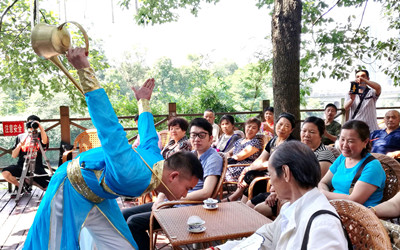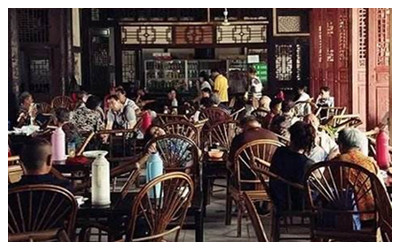- Home
- China Culture > Chinese Tea Culture >
Chinese Tea House
Tea house, a special place for the Chinese to have tea, is very popular everywhere in the Yangtze River area. It is mostly called tea house in provinces like Guangdong, Guangxi and Hainan. It is called tea pavilion in Beijing and Tianjin of North China. Although these names vary, the forms and contents are basically same.
To the Chinese people, tea house, similar to the cafes in western countries, are social places where various kinds of social information gather and spread and where customers taste tea and talk about birds, news and day things.
In order to attract customers, stages are built in some tea houses to play cross-talk, storytelling and Beijing opera, making these tea houses amusement places. The drama Tea House, written by the famous Chinese writer Lao She, revealed vividly the unstable society of the last phase of the Qing Dynasty through describing various kinds of people’s words and behaviors in a tea house.
The rise of tea house is closely related with Chinese tea culture. After several thousand years of development, the tea house has become a part of life for the Chinese people. Now, people come to Beijing will be attracted to those famous tea houses experiences Chinese tea culture.
Beijing Tea Houses
Many teahouses are located in Beijing's typical traditional courtyards and hutong areas, just outside the east gate of the Forbidden City and adjacent to Wangfujing Shopping Street, north east of the Tian'anmen Square, providing a resting and refreshing place for travelers coming afar to experience local Chinese lives and traditions back in a alley.
People may come in the early morning or in the afternoon and order a pot of tea served in the traditional Chinese Tea Ceremony style, chat and enjoy the unique Chinese music at the same time, until it closes late at night. Refills are always free of charge as long as the cup is left open.
Chengdu Tea Houses
 For Chengdu locals, it is very important to have the proper atmosphere to enjoy their tea. For most people, the perfect place would be a teahouse. The most popular location for teahouses in Chengdu is along the south bridge of Dujiang Weir, where the scenery is wonderful and the weather is pleasant.
For Chengdu locals, it is very important to have the proper atmosphere to enjoy their tea. For most people, the perfect place would be a teahouse. The most popular location for teahouses in Chengdu is along the south bridge of Dujiang Weir, where the scenery is wonderful and the weather is pleasant.
There is a kind of teapot that is unique to Chengdu. It is made of brass and has a spout that is approximately three feet long. The people in the teahouses that can use this style of teapot are called "Tea Doctors". The use of these teapots is an art in itself. The Tea Doctors spin the teapots and it resembles traditional martial arts. Because of the long spouts, the tea can be shot a very long distance.
The Tea Doctors can shoot the tea from across the room into a small teacup without spilling a drop. Visitors, who have the opportunity to witness this performance of pouring tea, will never forget it. This is something unique to Chengdu. The Tea Doctors besides being experts in the art of tea are also very familiar with the local culture and area and are the perfect source to find out about Chengdu's local customs, and places to visit

Jiangnan Tea Houses
In Jiangnan ( the area of South of Yangtse River), the morning tea is a ritual for many farmers, exclusively males.In each town, there is a tea-drinking session at one of numerous teahouses.
Jiangnan is as moist as Sichuan, but Jiangnan people have a sweet tooth. They prefer green tea, especially
Hangzhou's Longjing Tea or Suzhou's Biluochun Tea. They usually stay at the tea houses and sippe at a moderate speed until the tea turns so insipid you can no longer get the tea taste out of it.
In fact, this is the kind of idle chat that does not yield an iota of substance or drama. Yet these people - usually the old - do it day in and day out, rain or shine.

 For Chengdu locals, it is very important to have the proper atmosphere to enjoy their tea. For most people, the perfect place would be a teahouse. The most popular location for teahouses in Chengdu is along the south bridge of Dujiang Weir, where the scenery is wonderful and the weather is pleasant.
For Chengdu locals, it is very important to have the proper atmosphere to enjoy their tea. For most people, the perfect place would be a teahouse. The most popular location for teahouses in Chengdu is along the south bridge of Dujiang Weir, where the scenery is wonderful and the weather is pleasant.







 Ask Questions ?
Ask Questions ?